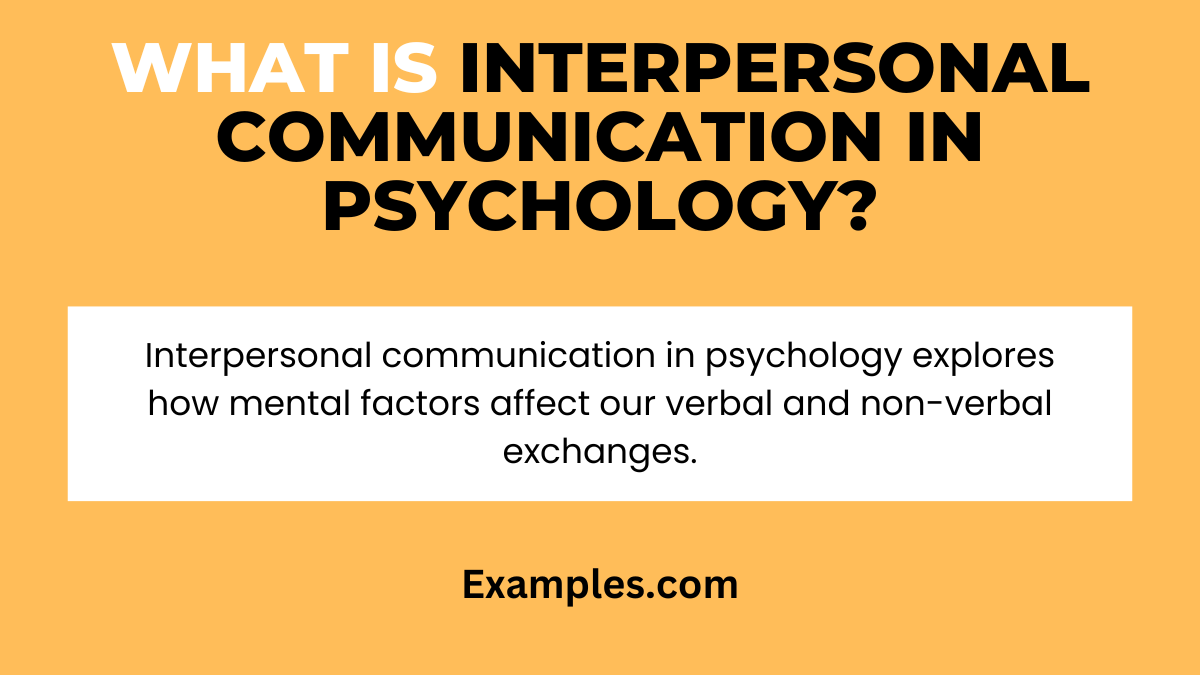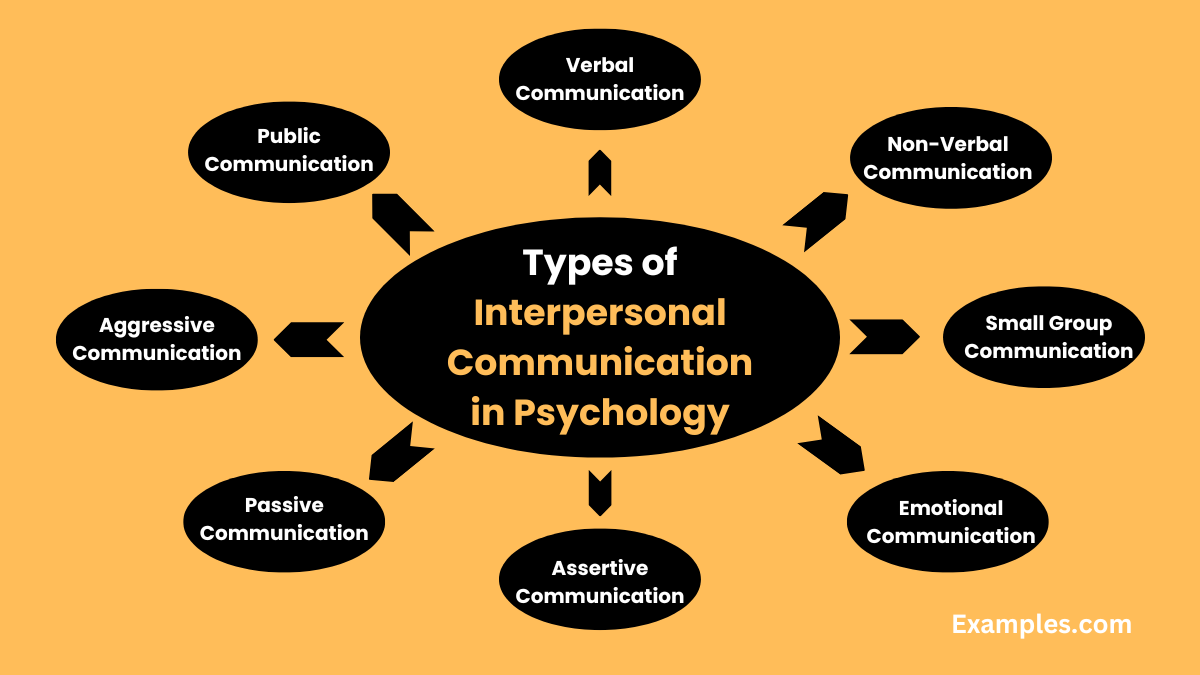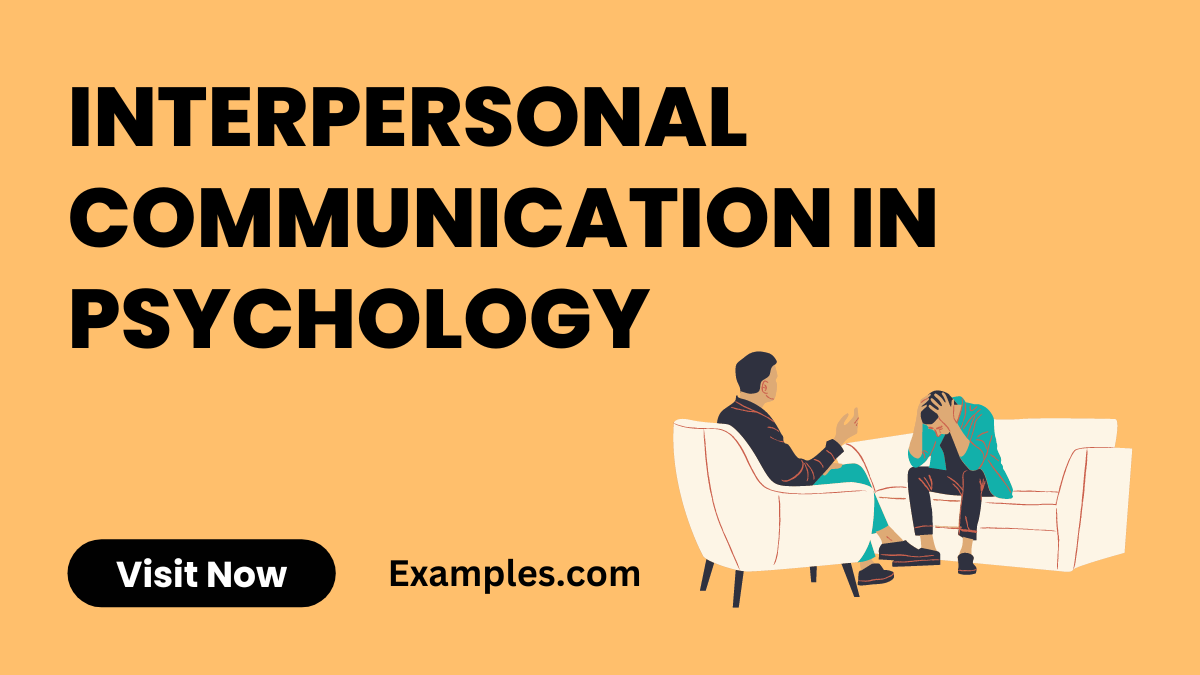9+ Interpersonal Communication in Psychology Examples
In the realm of psychology, interpersonal communication is more than just exchanging information; it’s about understanding the psychological underpinnings of how we interact. This includes examining how factors like perception, emotions, and social influences affect oral communication. Mastering these aspects can lead to more effective and empathetic interactions, both personally and professionally. Understanding the psychological aspects of communication helps in navigating complex social dynamics and fosters healthier, more satisfying relationships.
What is Interpersonal Communication in Psychology?

Interpersonal communication in psychology refers to the study and understanding of how individuals exchange information and how this process is influenced by psychological factors. It encompasses aspects of verbal and non-verbal communication, including how we convey and interpret messages based on our mental states, past experiences, and societal norms. This field explores how communication shapes and is shaped by psychological processes, playing a crucial role in forming and maintaining social relationships and impacting overall mental health and well-being.
10 Examples of Interpersonal Communication in Psychology
Interpersonal communication in psychology encompasses various forms, crucial for understanding and enhancing human interactions. These include verbal and non-verbal communication, active listening, emotional expression, and more. Each type plays a pivotal role in conveying thoughts, feelings, and intentions, vital for building healthy relationships and understanding human behavior. The following examples demonstrate the practical application of different aspects of interpersonal communication in everyday scenarios, underlining their significance in the field of psychology.
- Reflective Listening: “It sounds like you’re feeling overwhelmed by the workload. Is that correct?” Reflecting the speaker’s message to show understanding and empathy.
- Open-Ended Questions: “What were your feelings about that event?” Encouraging the speaker to share more detailed insights.
- Non-Verbal Cues: Maintaining eye contact during a conversation. Signals engagement and interest in the discussion.
- Assertive Communication: “I feel overlooked when my input isn’t considered in team meetings.” Expressing personal feelings and needs clearly and respectfully.

- Conflict Resolution: “Let’s work together to find a compromise that suits us both.” Aiming for collaborative problem-solving.
- Positive Reinforcement: “Your contribution to this project really made a difference.” Recognizing and appreciating others’ efforts.
- Empathetic Response: “That sounds like a difficult situation. How can I support you?” Demonstrating understanding and offering support.
- Setting Boundaries: “I need some space right now to process this information.” Clearly communicating personal limits.

- Feedback Giving: “Your report was very thorough. Adding more case studies could enhance it further.” Offering constructive criticism for improvement.
- Paraphrasing: “So, you’re feeling anxious about tomorrow’s presentation?” Restating the speaker’s words to confirm understanding.
Types of Interpersonal Communication in Psychology

| Type | Description |
|---|---|
| Verbal Communication | Involves the use of spoken or written words to convey messages and emotions. |
| Non-Verbal Communication | Includes body language, facial expressions, and other visual cues that complement or contrast with verbal communication. |
| Active Listening | A skill where the listener fully concentrates, understands, responds, and then remembers what is being said. |
| Emotional Communication | The expression and interpretation of emotions through tone, word choice, and physical expressions. |
| Assertive Communication | Involves expressing one’s opinions and needs in a clear, honest, and respectful way. |
| Passive Communication | Characterized by a reluctance to express thoughts and feelings openly. |
| Aggressive Communication | Involves expressing oneself in a forceful and often disrespectful way. |
| Passive-Aggressive Communication | Indirect expression of hostility, such as through subtle insults or sullen behavior. |
| Public Communication | Interactions that occur in a public setting or with a larger audience. |
| Small Group Communication | Communication within a small group, often involving collaboration and problem-solving. |
What is the Psychological Theory of Interpersonal Communication?
- Social Learning Theory: Highlights that communication behaviors are learned through observation and imitation in social contexts.
- Attachment Theory: Explains how early life attachments influence future communication styles and relationship building.
- Cognitive Dissonance Theory: Focuses on the discomfort and subsequent communication adjustments when faced with conflicting beliefs or ideas.
- Social Exchange Theory: Views communication as a transaction, analyzing the costs and benefits of interactions.
- Symbolic Interactionism: Emphasizes the creation of shared meanings and understandings through communication.
- Elaboration Likelihood Model: Explores how individuals process persuasive communication based on their motivation and ability to engage.
- Spiral of Silence Theory: Describes the tendency to remain silent when one’s views are opposed to the perceived majority opinion.
- Politeness Theory: Investigates how people communicate to maintain positive relationships and avoid offending others.
- Uncertainty Reduction Theory: Stresses the role of communication in reducing uncertainties in interpersonal interactions.
- Expectancy Violations Theory: Examines how people respond when their communication expectations are violated.
What are the Psychological Functions of Interpersonal Communication?
- Identity Formation: Communication aids in expressing and shaping one’s identity and self-concept.
- Emotional Expression: Vital for expressing and understanding emotions in interpersonal relationships.
- Social Interaction: Facilitates social connections and maintains relationships.
- Information Exchange: Essential for sharing and receiving knowledge and understanding.
- Influence and Persuasion: Communication as a tool for influencing thoughts, beliefs, and actions of others.
- Decision Making: Helps in collaborative decision-making processes in personal and professional contexts.
- Conflict Resolution: Addresses and resolves interpersonal conflicts through effective communication.
- Stress Reduction: Venting and discussing problems can reduce stress and emotional burden.
- Social Support: Provides emotional support and reassurance in relationships.
- Relationship Building and Maintenance: Fundamental for initiating and sustaining personal and professional relationships.
Importance of Interpersonal Communication in Psychology
- Understanding Emotions: Helps in recognizing and interpreting emotional states of oneself and others.
- Building Relationships: Essential for forming and maintaining personal and professional relationships.
- Conflict Resolution: Facilitates resolving misunderstandings and disputes effectively.
- Enhancing Empathy: Improves the ability to understand and share the feelings of others.
- Promoting Mental Health: Effective communication can improve overall mental well-being and reduce stress.
- Influencing Behavior: Plays a crucial role in influencing and changing behaviors in various settings.
- Facilitating Decision Making: Essential for collaborative decision-making processes and achieving consensus.
- Improving Patient Care: In healthcare, clear communication leads to better patient outcomes and satisfaction.
- Cultural Understanding: Enables appreciation and respect for cultural differences in communication styles.
- Educational Development: Enhances teaching and learning experiences through clear and effective communication.
Effective interpersonal communication is a cornerstone of strong and healthy relationships. Understanding its psychological aspects and functions helps navigate complex interactions and build deeper connections. By mastering various communication styles and being aware of the psychological underpinnings, individuals can significantly improve their personal and professional relationships. This guide underscores the importance of communication skills for a fulfilling and harmonious relationship experience.



